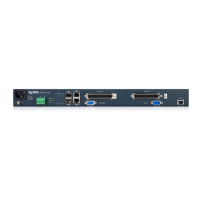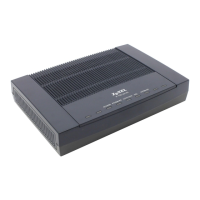Chapter 32 PPPoE IA
VES1724-56 User’s Guide
299
32.6.3 PAEPVC Configuration
Click Advanced Application > ADSL Fallback in the navigation panel, and then click the
PAEPVC link to display the screen as shown. Use this screen to view and configure PPPoA-to-PPPoE
(PAE) PVCs for PAE translation on individual ports.
Figure 183 Advanced Application > ADSL Fallback > PAEPVC
The following table describes the labels in this screen.
Table 139 Advanced Application > ADSL Fallback > PAEPVC
LABEL DESCRIPTION
Active Select the check box to enable this channel.
Port Enter the number of DSL port for which to configure a channel.
VPI Enter the VPI (Virtual Path Indicator) from 0 to 255 for a channel on a port. The VPI and VCI
identify a channel.
VCI Enter the VCI (Virtual Channel Indicator) from 32 to 65535 for a channel on a port.
PVID Enter the PVID (Port VLAN ID) that the Switch assigns to untagged frames received on this
channel.
This must be the VLAN ID of a VLAN that is already configured. The port that you are
configuring and the uplink port must also be set to the fixed status in the VLAN.
You should also select Tx Tagging for the VLAN to have the Switch tag all the outgoing
frames on the DSL port with this VLAN ID.
Encapsulation Specify the encapsulation type (llc or vc) for this channel.
Priority Assign a default IEEE 802.1p default priority (0 to 7). This is the priority value to add to
incoming frames without a (IEEE 802.1p) priority tag.
Add Click Add to insert a new PAEPVC entry to the Switch’s run-time memory. The Switch loses
these changes if it is turned off or loses power, so use the Save link on the top navigation
panel to save your changes to the non-volatile memory when you are done configuring.
Cancel Click Cancel to reset the above fields to your previous configuration.
Index This is the index number of the channel on this port. Click a number to edit that channel.

